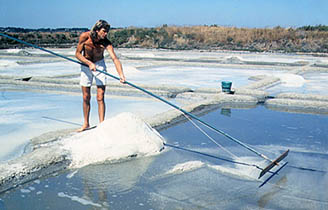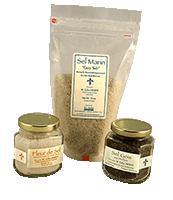

Hirschmann Styrian Pumpkin Seed Oil
Antara
Cooperative L'Oulibo
Le Vinaigre De Banyuls
Agusti Torelló
Agredolç de Vi
José Paez Lobato
Fleur de Sel
Flor de Sal
Hawaiian Alaea Sea Salt
Salts & Spices
E & A Gispert
Blai Peris Olives
Ecoficus Fig Cakes
Valliser Membrillo
Nougat De Montelimar
Torrons i Mel Alemany
La Maison d'Armorine
Fleur de Sel and Sel Gris
Fleur de Sel and Sel Gris are all-natural sea salts from Brittany, France. They are unprocessed, unrefined, and unadulterated. They do not contain anti-caking or anti-flowing agents. Sel Gris aux Herbes contains Sel Gris and air-dried bay, thyme, basil and rosemary.

du pays Guérandais
fait par: M. Gilles HERVY
Artisan Paludier
In Brittany, France near the town of Guèrande there are marshes and low-lying areas that have been salt fields for centuries because of a mini climate that is much milder than the rest of the surrounding area. There, the currents of the Atlantic run cleaner than in many of the other salt harvesting regions of France. Guèrande has no peer in Europe for the quality of salt produced.
The salt fields of Guèrande are long and narrow so that an artisan paludier (craftsman salt harvester) like Gilles HERVY can "sweep" with a float, the crystallized top of the evaporating sea water to harvest the precious Fleur de Sel de Guèrande. On warm, breezy afternoons (i.e.: when there is no rain) a single day's evaporation of salt crust on top of the salt ponds is harvested as the Fleur de Sel, the least salty, purest part of the saline. What remains and crystallizes through-out the season is the Sel Gris. The harvest ("forming") is usually from May to September. For every 80 pounds of Sel Gris produced, there is one pound of Fleur de Sel that is harvested.

The taste of Fleur de Sel is a complex balance of the sea and her minerals, with small flaky crystals, a moist texture and a slight grey/pink cast. The Sel Gris is a larger crystal with a distinct grey color and stronger salt/mineral flavor. The dimension of the taste of salt that is most apparent first is mouth feel/texture. Another prominent aspect of salt is the level and taste complexion of the minerals. With hand-harvested salt these subtext taste influences actually come from the minerals in the clay that lines the beds. Whenever you talk to a paludier you hear very little about what one would expect... raking/making salt. Most of what they concentrate on is maintaining the beds, the clay lining. And this clay comprises the mineral content of the salt and this is what makes the SUBTLE distinctions of salt flavor by region.
The Gilles HERVY (husband, wife, two sons, daughter) family has chosen to remain independent from the typical marketing cooperative used by most paludier in the Brittany region. While the Hervy family has gained independence from this arrangement in large part due to their direct sales (in France, at shows and roadside stands) their export efforts particularly in the U.S has been an added boon to their desire to remain independent and carry on the paludier tradition. They own two salines (salt pond areas). Mr. Hervy's independence and integrity caused them particular hardship when he refused to supplement his production stockpile with salt from other regions after the breakup of the tanker "Erika" off the Brittany coast in 1999, but has paid off in the long run with consistent best quality product resulting in a loyal clientele.